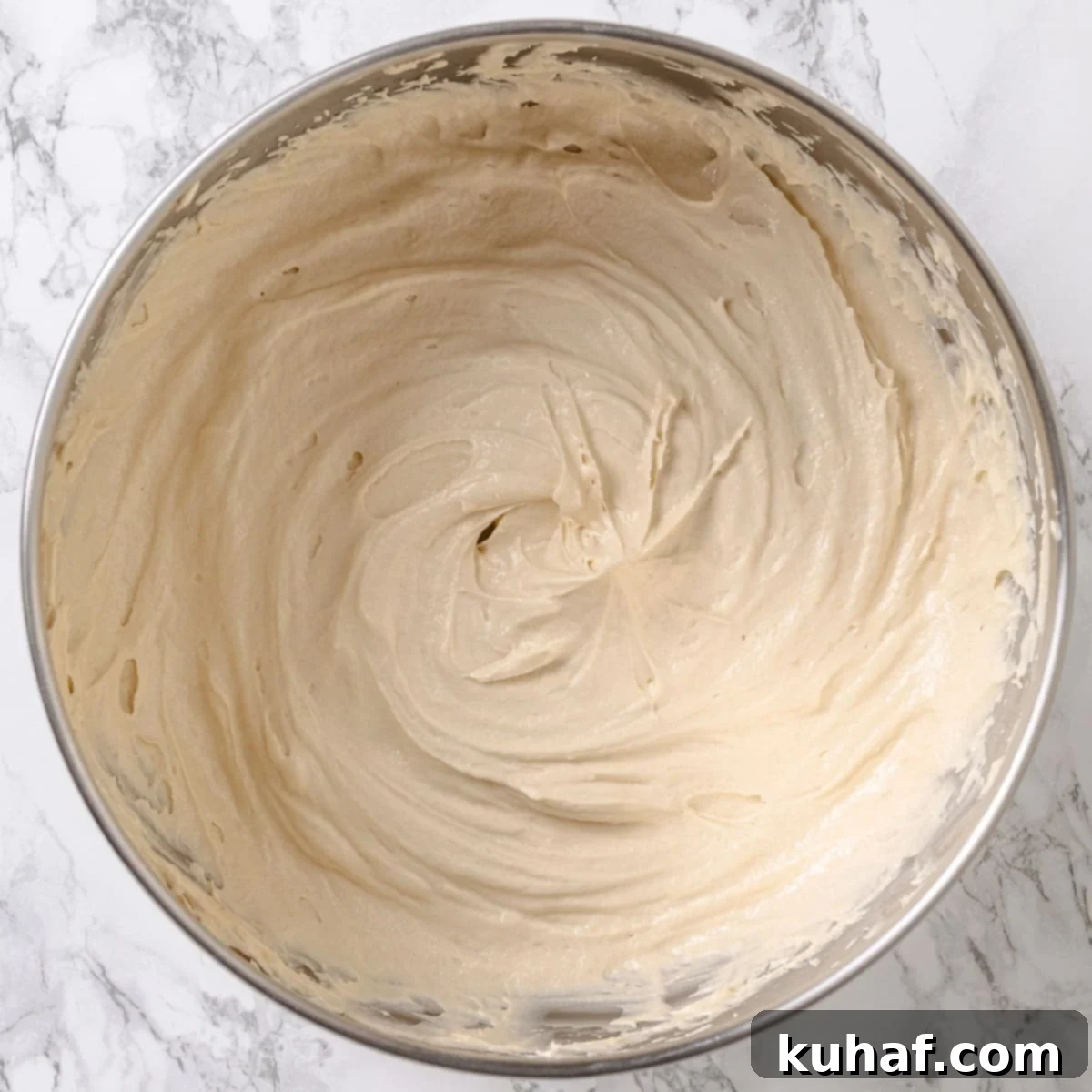The Ultimate Stable & Creamy Maple Frosting: A Cooked Flour Masterpiece for Fall Desserts
Discover the secret to a truly exceptional maple frosting with this recipe, featuring a unique cooked flour base and the rich, unmistakable flavor of real maple syrup. This method yields a frosting that is wonderfully stable, luxuriously rich, and surprisingly airy all at the same time, making it the perfect topping for your favorite autumnal treats. Prepare to elevate your baking with a frosting that stands apart from the rest!
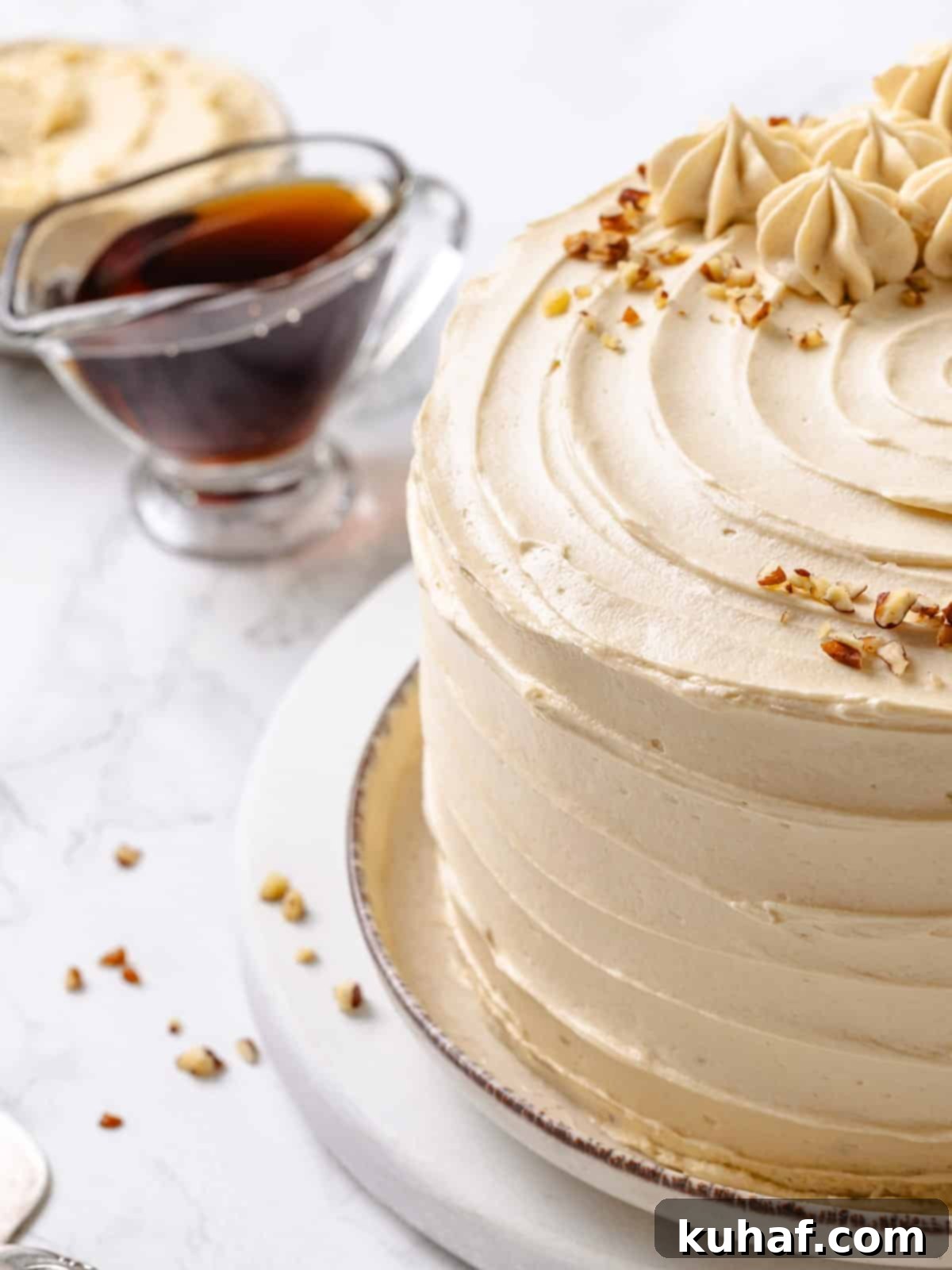
When you hear “cooked flour” in the context of frosting, your mind might jump to a savory roux, but rest assured, this maple frosting is a delightful departure from that notion. This unique approach creates a frosting that is perfectly balanced in sweetness, allowing the deep, authentic flavor of pure maple syrup to shine through. The cooked flour base provides incredible stability, while the generous addition of butter and sugar ensures a velvety smooth, rich, and intensely creamy texture that holds its shape beautifully.
While I’m a huge enthusiast for classic Swiss meringue buttercream due to its silky nature, exploring different frosting techniques can open up a world of new flavors and textures. This cooked flour maple frosting offers a refreshing change and is incredibly versatile. Much like my easy marshmallow frosting recipe, which I adore on sweet potato casserole cupcakes or piled high on my easy pumpkin pie, this maple rendition promises to become a new favorite for your fall baking adventures.
Why You Will Love This Maple Frosting
This maple frosting isn’t just another sweet topping; it’s a game-changer for anyone seeking a truly superior dessert experience. Here’s why you’ll fall in love with it:
- Light, Fluffy, and Exceptionally Stable! Unlike many buttercreams that can be prone to melting or losing shape, this cooked flour frosting boasts the airy lightness of whipped cream combined with the robust stability of an Italian meringue buttercream. This means your beautifully piped decorations will hold their form, even in warmer environments, making it ideal for everything from intricate cake designs to outdoor celebrations. Its resilience ensures your desserts look as good as they taste for longer.
- The Perfect Seasonal Switch-Up for Fall Cakes. As the leaves change and the air turns crisp, our cravings shift towards warm, comforting flavors. This maple frosting is an exquisite addition to your autumn dessert repertoire, offering a sophisticated and seasonal alternative to traditional vanilla or chocolate frostings. It’s truly spectacular when generously piped on top of pumpkin cupcakes, swirled onto a moist applesauce cake, or even spread over a warm pecan pie. Its rich, inviting flavor perfectly complements the spices and fruits of fall.
- Authentic and Uncloyingly Sweet Maple Syrup Flavor. Many maple-flavored frostings rely on extracts, which can sometimes taste artificial or overwhelmingly sweet. This recipe, however, champions the use of real, pure maple syrup. By cooking the maple syrup with the flour, we achieve a subtle reduction, concentrating its natural depth and rich, earthy notes without adding excessive moisture. The result is a profoundly flavorful frosting that celebrates the true essence of maple without being overly sugary, allowing the genuine taste of the syrup to be the star.
Table of Contents
- Why You Will Love This Maple Frosting
- Ingredients & Substitutions
- Variations to Explore
- Professional Tips for Perfect Frosting
- How to Make Maple Frosting: Step-by-Step Guide
- Chef Lindsey’s Recipe Tip
- Recipe FAQs
- Recommended Fall Dessert Recipes
- Maple Frosting Recipe Card
- Before You Go
Ingredients & Substitutions for Maple Frosting
Crafting the perfect maple frosting begins with understanding the role each ingredient plays. Here’s a breakdown of what you’ll need and potential alternatives:
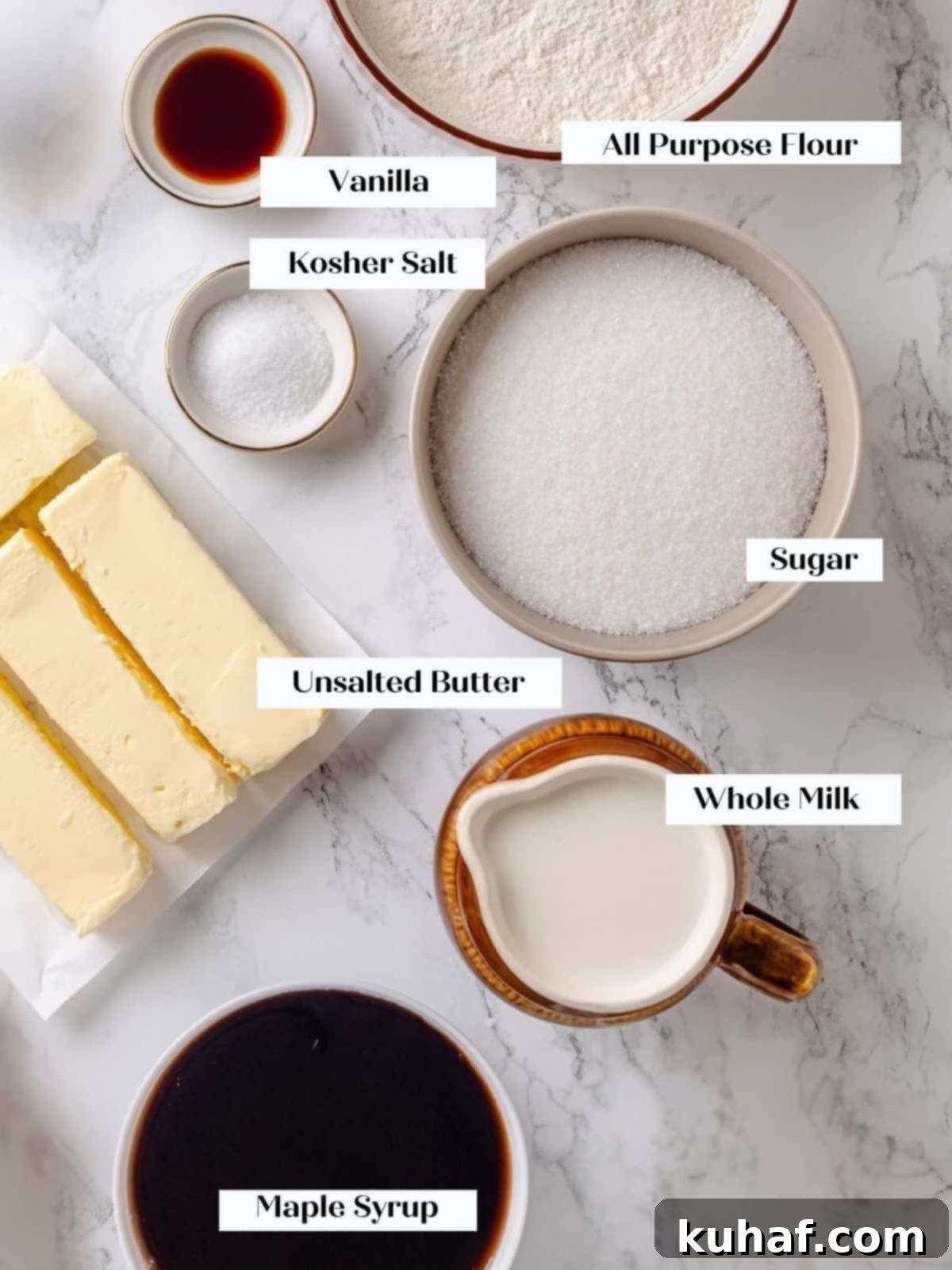
- All-Purpose Flour: This is the backbone of our unique cooked flour base, essential for thickening and stabilizing the frosting. It’s what gives this frosting its incredible structure and resilience. While you could attempt a gluten-free all-purpose flour blend, be aware that the final texture may be noticeably grainier. For a reliably smooth, gluten-free frosting, consider flavoring a classic American buttercream or a luscious cream cheese buttercream with maple syrup and extracts instead.
- Whole Milk: The fat content in whole milk contributes significantly to the richness and creamy mouthfeel of this frosting. It also enhances the overall flavor profile. You can substitute with a dairy-free milk alternative (such as almond or oat milk), but be mindful that these alternatives can impart their own subtle flavors to the finished frosting. Choose a plain, unsweetened variety for the most neutral impact.
- Maple Syrup: This is the star ingredient! For the absolute best texture and deepest, most authentic maple flavor, it is crucial to use pure maple syrup, specifically Grade A: dark amber, rich taste (which was formerly known as Grade B). This grade has undergone a longer reduction process before bottling, concentrating its flavor and removing more moisture, resulting in a more intense and complex maple profile that is essential for this recipe. Avoid artificial syrups or those labeled “pancake syrup.”
- Granulated Sugar: Sugar provides sweetness and helps with the frosting’s structure. If you prefer a less sweet frosting, you have the flexibility to reduce the granulated sugar down to ½ cup, or anywhere in between ½ cup and ⅔ cup, without significantly impacting the stability.
- Unsalted Butter: While this frosting uses less butter than some traditional buttercreams like Swiss meringue buttercream, it still calls for a substantial amount. Using unsalted butter allows you to control the overall saltiness of the frosting. Ensure your butter is cold but pliable – not rock-hard from the fridge, but definitely not soft or melted. This temperature is key for achieving the correct emulsion and a stable, pipeable frosting.
- Vanilla Extract: A touch of vanilla extract rounds out the flavor profile, complementing the maple without overpowering it. Use a good quality pure vanilla extract for the best results.
- Kosher Salt: A small amount of kosher salt is vital to balance the sweetness and enhance all the other flavors, preventing the frosting from tasting flat.
Refer to the recipe card below for precise measurements and comprehensive ingredient information.
Variations to Explore
This maple frosting recipe is wonderfully adaptable, allowing you to experiment with different flavors and infusions to suit your taste or the dessert you’re pairing it with. Get creative with these delicious variations:
- Experiment with Different Syrups. Beyond maple, you can completely transform the flavor profile by incorporating other rich syrups. Try using robust molasses for a deeper, more treacle-like frosting that’s perfect for gingerbread, or golden honey for a delicate floral sweetness. You could even use the luscious syrup from Fabbri Amarena Cherries for a sophisticated, fruity twist, creating a beautiful contrast with rich chocolate cakes.
- Switch it Up with a Fruit Reduction. For a unique and intense fruity flavor, replace some or all of the maple syrup with a homemade fruit reduction. Similar to how I create the concentrated apple flavor for my apple cider donut recipe, you can reduce apple cider, pear juice, or even a spiced berry juice until it’s thick and syrupy. This concentrated fruit liquid will infuse your frosting with vibrant, natural sweetness and tang.
- Infuse the Milk with Aromatics. Take your frosting to the next level by infusing the milk with whole spices or nuts. Gently simmer more milk than the recipe calls for with whole spices like nutmeg, cinnamon sticks, vanilla beans, star anise, or cloves. For a nutty flavor, toast almonds or hazelnuts lightly before adding them to the milk. Once simmered, cover the mixture and let it steep for several hours, or even overnight, in the refrigerator to allow the flavors to fully develop. Strain the milk thoroughly before measuring and using it in your frosting base.
- Flavor with Extracts for Quick Changes. If you’re looking for an alternative method or simply want to adjust the maple intensity, you can start with a basic ermine frosting recipe (a cooked flour frosting base) and introduce maple extract. This allows for precise control over the maple flavor. Maple extract can also be a delightful addition to other buttercream styles, such as a classic Italian meringue buttercream, or used to enhance a rich caramel Swiss meringue buttercream, creating a harmonious and indulgent combination.
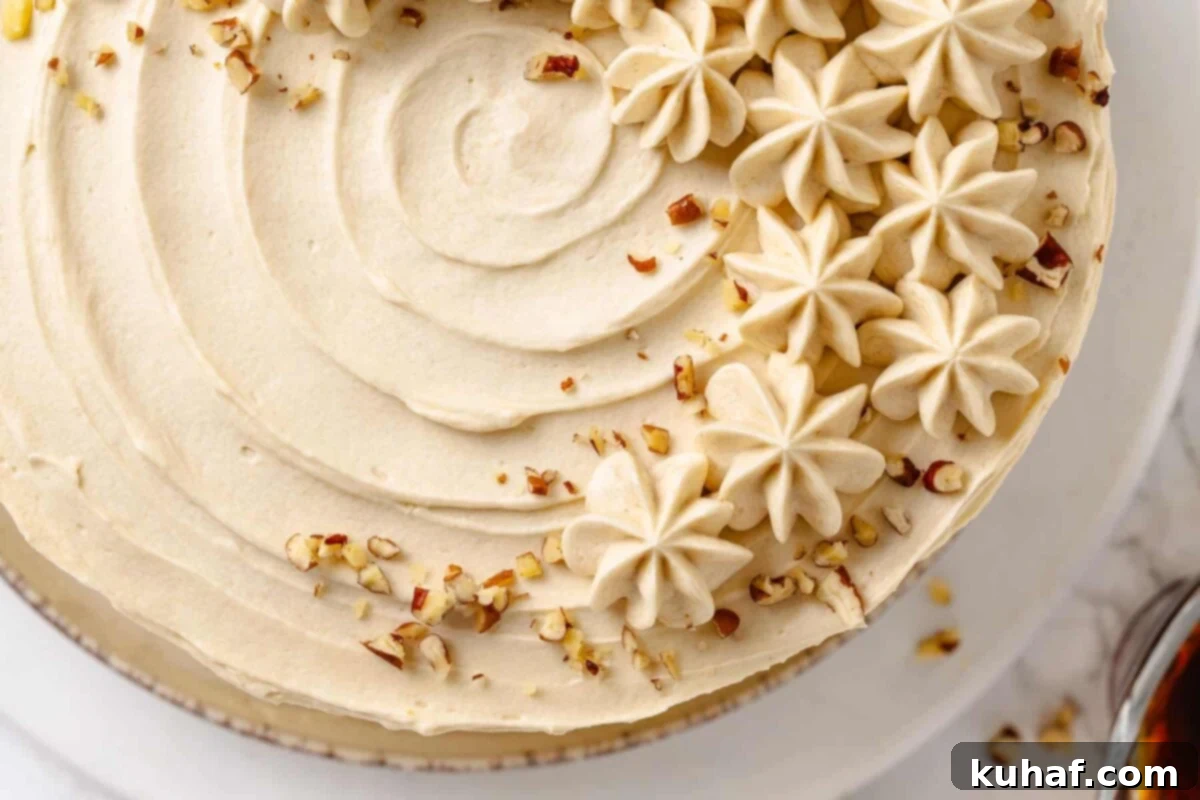
Professional Tips for Perfect Maple Frosting
Achieving bakery-quality maple frosting is easier than you think with these expert tips:
- Ensure the Flour Base is Thoroughly Cooked. This is perhaps the most critical step for stable frosting. It can be tricky to know exactly when to stop cooking the flour base, but visual cues are key. The mixture should become very thick, forming distinct clumps that “plop” off your spoon or spatula rather than pouring in a stream. When you drag your spoon through the bottom of the pan, it should leave a clear line that holds for a moment before the mixture slowly fills it in. The consistency of this cooked base directly dictates the stability and pipeability of your final frosting, ensuring it holds beautiful shapes and details. Aim for a consistency similar to very thick mashed potatoes.
- Use Cold, But Pliable Butter. The temperature of your butter is paramount for proper emulsification. It needs to be cold enough to incorporate slowly and create a stable emulsion, but pliable enough to beat into a light and fluffy consistency. If your butter is too warm, it will melt into the base prematurely, resulting in a soft, runny frosting that won’t hold its shape. If it’s too cold and hard, it won’t cream properly. A trick if your butter is too cold: you can cream it in your stand mixer with the paddle attachment, gently warming the outside of the bowl with a kitchen torch for just a few seconds at a time until it reaches the correct pliable consistency. Then switch to the whisk attachment for whipping.
- Invest in High-Quality Maple Syrup. This recipe truly shines with the best ingredients. Now is the time to splurge on genuine, pure maple syrup. Specifically, seek out Grade A: dark amber, rich taste. This grade offers a deeper, more concentrated maple flavor compared to lighter grades, and it also contains less moisture. Using superior maple syrup will dramatically enhance the flavor of your frosting, providing authentic sweetness and depth without diluting the texture. Plus, you’ll have plenty left over to make other delicious treats like this maple bundt cake!
- Cool the Flour Base Completely. After cooking, it is absolutely essential to allow your flour base to cool completely to room temperature before adding it to the whipped butter. Any residual warmth in the base will melt the butter, leading to a soupy, unstable frosting that won’t firm up. Covering it with plastic wrap pressed directly onto the surface prevents a skin from forming. Patience is key here, or you can expedite the cooling by stirring it in intervals in the refrigerator until it’s cool to the touch (around body temperature).
How to Make Maple Frosting: Step-by-Step Guide
Follow these detailed instructions to create a truly fluffy, silky-smooth, and perfectly stable maple frosting that will impress everyone. Full measurements and additional specifics are provided in the comprehensive recipe card below.
Part 1: Make the Cooked Flour Base
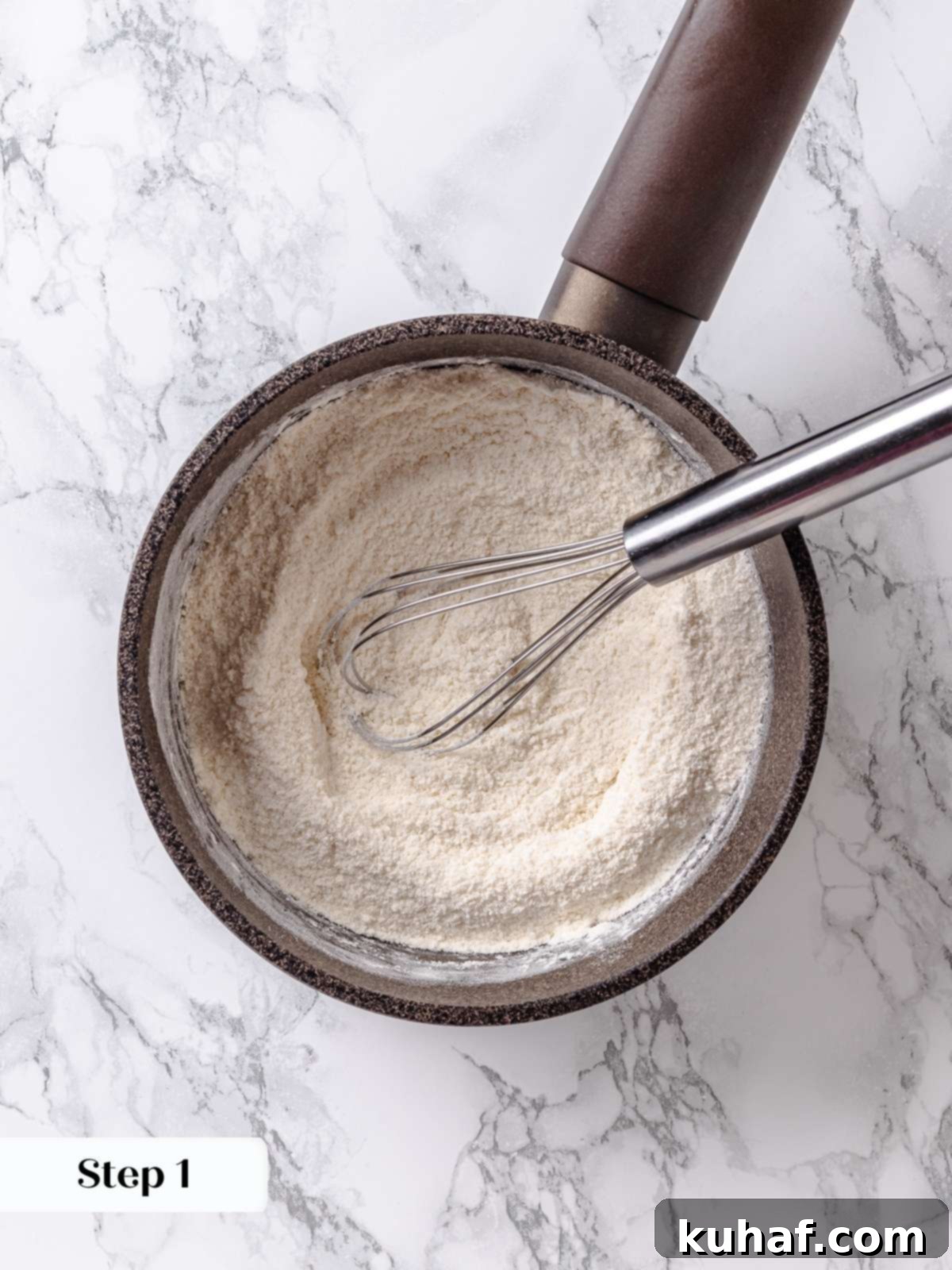
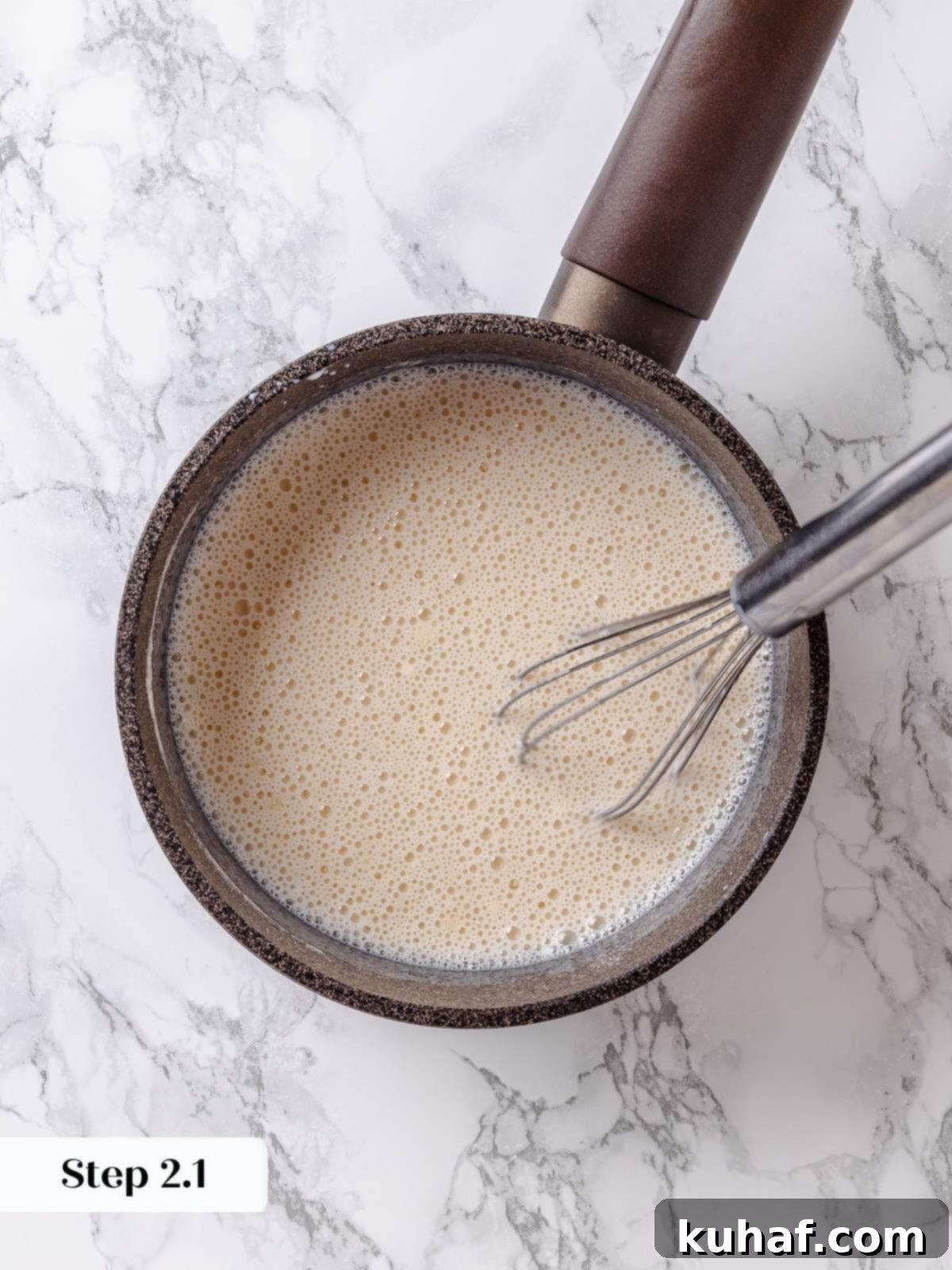
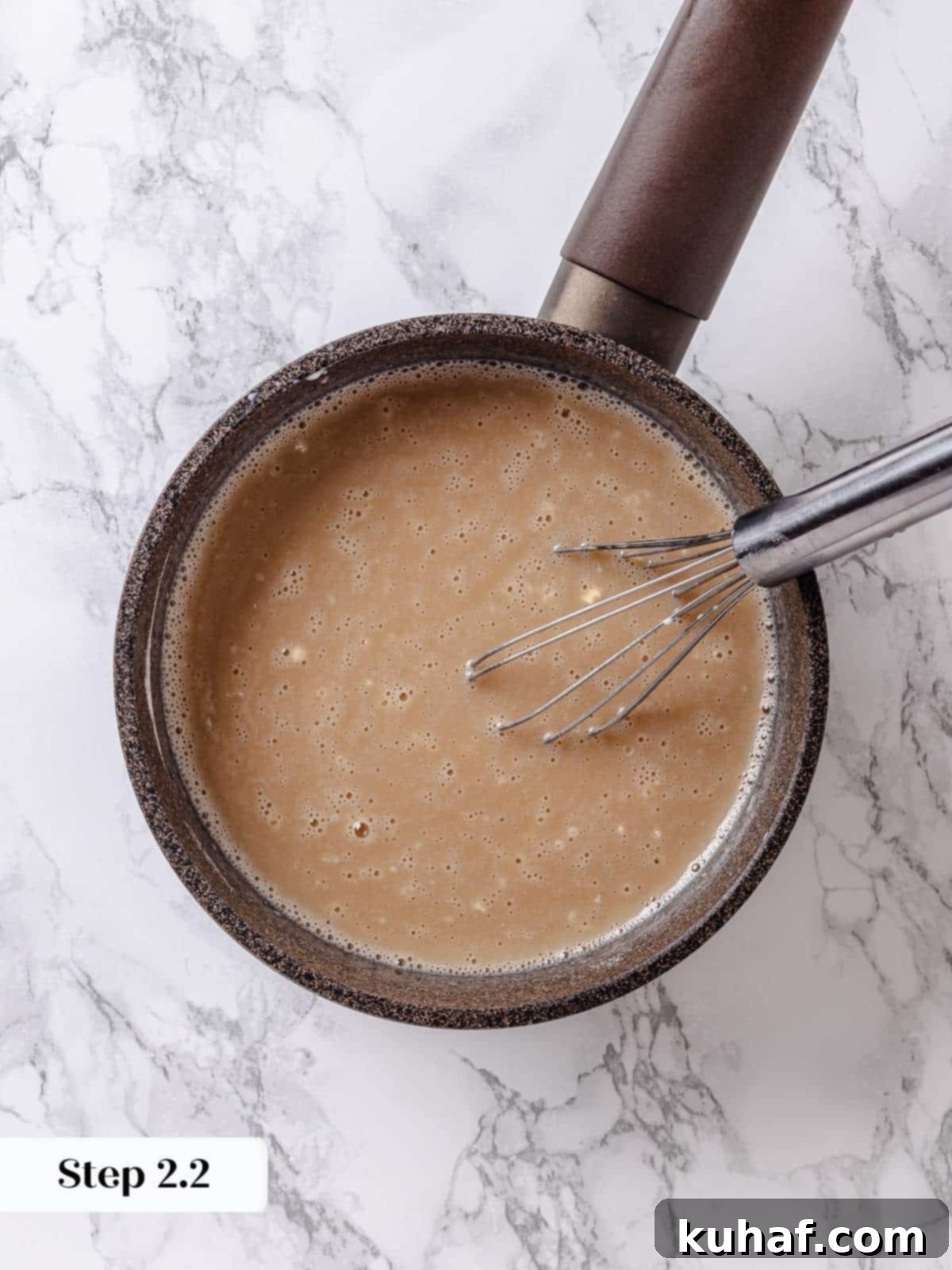
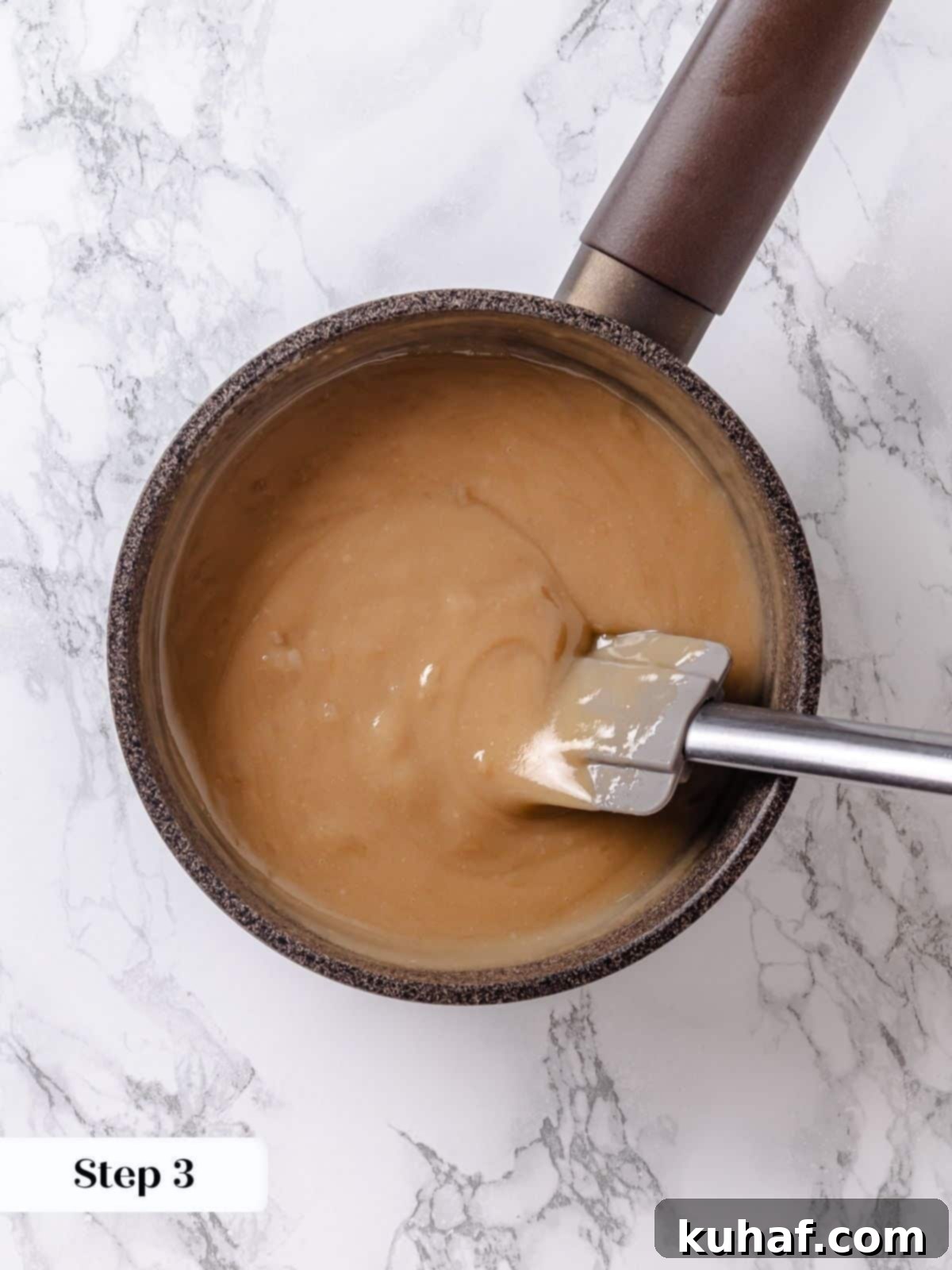
Step 1: Combine Dry Ingredients. In a large, heavy-bottomed saucepan, measure out the all-purpose flour, granulated sugar, and kosher salt. Stir these dry ingredients together thoroughly with a whisk to ensure they are well combined and there are no lumps of flour (photo 1).
Step 2: Gradually Add Liquids. Begin slowly whisking in the whole milk, adding only a small amount at a time (photo 2). It’s crucial to whisk constantly and ensure each addition of milk is fully incorporated into the dry mixture before adding more. This gradual process is key to preventing lumps and achieving a smooth base, much like when you’re making a perfect homemade vanilla pudding. Once the milk is incorporated, whisk in the pure maple syrup (photo 3). The mixture will still be quite thin at this stage.
Step 3: Begin Cooking the Base. Switch from the whisk to a heat-resistant silicone spatula. Place the saucepan over medium heat and begin stirring constantly (photo 4). Continuous stirring is vital to prevent the flour mixture from sticking to the bottom of the pan and burning, which would impart an unpleasant flavor and texture. Focus on scraping the entire bottom and corners of the pan.
CHEF’S TIP: To ensure even cooking and prevent scorching, I recommend using a specific stirring technique. Move your spatula in a zig-zag pattern across the bottom of the pot, then sweep it around the edges, repeating this pattern. This method ensures you’re consistently scraping the entire cooking surface, just like when preparing delicate sauces like crème anglaise or a smooth easy lemon curd!
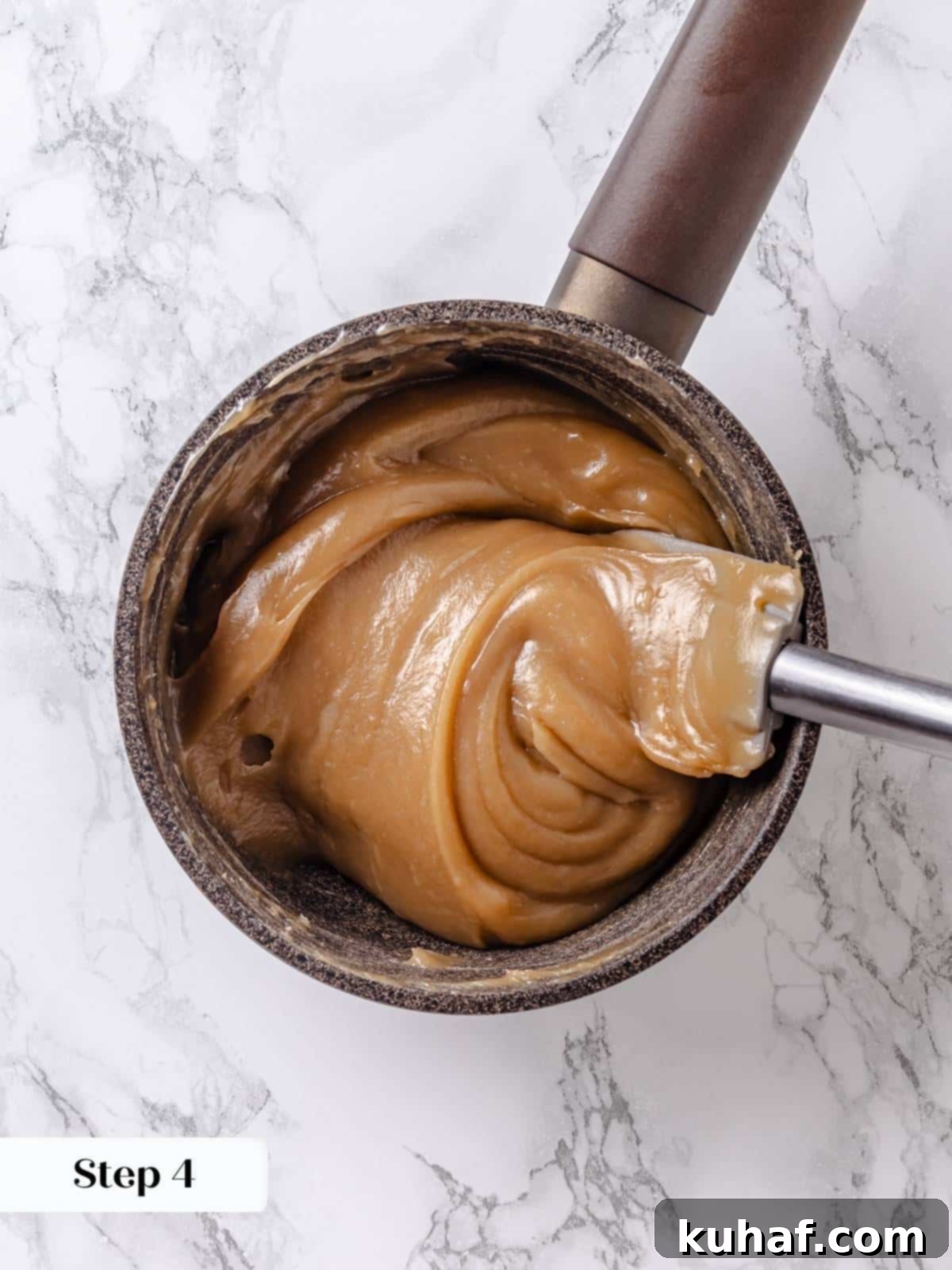
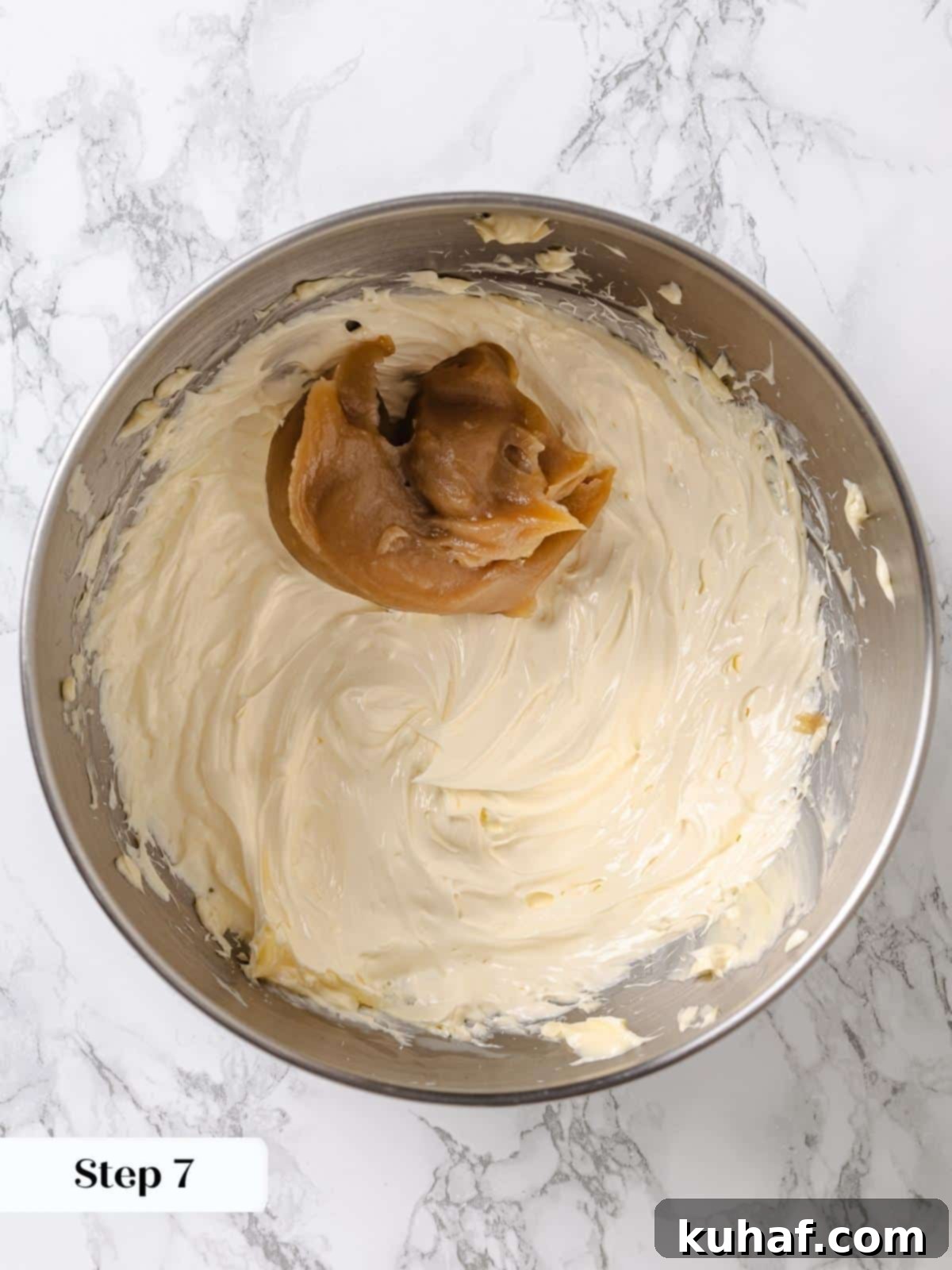
Step 4: Cook Until Thickened. Continue stirring and cooking the mixture over medium heat until it has visibly thickened considerably. It should reach a consistency where it no longer pours off the spoon in a thin stream but rather drops off in distinct, thick clumps (photo 5). This process typically takes about 20-25 minutes. Do not rush this step, as the proper thickening of this base is directly correlated to the stability, texture, and pipeability of your final frosting. A thoroughly cooked and thick base will produce a frosting that holds elegant lines and intricate details beautifully, even in challenging conditions of high heat and humidity. You’ll know it’s ready when it forms thick ribbons or clumps and you can easily see the bottom of the pan as you stir.
Step 5: Cool the Flour Base. Once the mixture has reached the desired thickness, remove the saucepan from the heat. Scrape the entire cooked flour base into a clean, large bowl using your silicone spatula. To prevent a skin from forming on the surface, immediately cover the top of the mixture with plastic wrap, pressing it directly onto the surface to eliminate air pockets. Allow the base to cool completely at room temperature until it is no longer warm to the touch. This cooling process is crucial! For faster cooling, you can place the covered bowl in the refrigerator, stirring it every 20 minutes and repeating until it reaches body temperature or is entirely cool. It must be cool before proceeding.
Part 2: Make the Maple Frosting
Step 6: Whip the Butter. In the bowl of a stand mixer fitted with the whisk attachment, place your cold but pliable unsalted butter. Beat the butter on medium-high speed for several minutes, allowing it to become incredibly fluffy and almost white in color (photo 6). This aeration is essential for a light and airy frosting.
Step 7: Incorporate the Maple Base. With the mixer still running on medium speed, begin adding the completely cooled maple flour mixture one spoonful at a time. Allow each spoonful to beat in fully and thoroughly before adding the next. This slow and gradual addition is critical for creating a smooth, stable emulsion. Periodically stop the mixer to scrape down the sides and bottom of the bowl with your spatula, ensuring all ingredients are evenly combined (photo 7).
Step 8: Final Scrape and Mix. After all the maple mixture has been added, stop the mixer one last time. Use your spatula to give the bowl a final thorough scrape down, ensuring no unmixed butter or base remains on the sides or bottom. This guarantees a homogenous and perfectly smooth frosting.
Step 9: Add Vanilla and Whip to Peaks. Add the vanilla extract to the bowl. Increase the mixer speed to high and continue to whisk for several more minutes until the frosting becomes light, fluffy, and holds stiff peaks (photo 8). It should look voluminous and glossy. This whipping phase is key to achieving its characteristic airy texture.
Step 10: Serve or Store. Your beautiful maple frosting is now ready! Transfer it to a piping bag for decorating cupcakes, or spread it generously onto cakes, like my beloved maple cake, for a delightful finish.
Chef Lindsey’s Recipe Tip
I always find that this maple frosting is at its absolute peak texture and easiest to work with immediately after it’s made. The fresh whip provides optimal lightness and pliability for piping and spreading. While you can certainly store it for later use in an airtight container in the refrigerator, and then re-whip it, please note that it might not regain quite the same level of airy fluffiness as when it’s freshly prepared. It will still be delicious and perfectly usable, just potentially a bit denser.
Recipe FAQs About Maple Frosting
This maple frosting stores exceptionally well! Keep it in an airtight container in the refrigerator for up to 2 weeks. For longer storage, you can freeze it for up to 2 months. As mentioned in my tip, this frosting has the best texture when used fresh. However, if you need to prepare it in advance, simply remove it from the refrigerator or freezer (thaw overnight in the fridge), let it come to room temperature, and then re-whip it with a stand mixer for a few minutes until fluffy again. You can also make just the cooked flour base ahead of time and store it; allow it to reach room temperature before adding it to the softened butter.
There are two primary reasons why your maple frosting might be too runny. First, the cooked flour base might not have been cooked long enough. It needs to be very thick and hold its shape off a spoon to provide adequate stability. Second, if the butter you used was too warm or if the cooked flour base was still warm when added to the butter, it can cause the emulsion to break, leading to a soupy consistency. Ensure both the butter is pliable-cold and the flour base is completely cooled.
Yes, this cooked flour maple frosting sets beautifully firm in the refrigerator due to its high butter content. This firmness makes it excellent for layered cakes or for transporting desserts. Despite setting hard, it remarkably retains a wonderfully light and creamy texture once it comes back to room temperature, or even when enjoyed slightly chilled. It won’t become brittle or greasy.
This versatile maple frosting is perfect for so much more than just cakes and cupcakes! Use it to create delightful layers between cake rounds, pipe intricate designs on top of individual cupcakes, or even spread it generously as a filling for whoopie pies or sandwich cookies. It would be particularly delightful sandwiched in between these chewy molasses cookies, offering a rich, spiced complement. Consider replacing the traditional glaze on top of my apple cinnamon rolls with a dollop of this frosting for an extra decadent touch, or even swirling it into hot cocoa for a gourmet treat!
Yes, you absolutely can! The recipe already suggests reducing the granulated sugar down to ½ cup if you prefer a less sweet frosting. This won’t significantly impact the overall stability, just the sweetness level. For a truly less sweet option where the maple flavor is the primary highlight without much added sugar, you might consider my ermine frosting recipe and flavoring it predominantly with maple extract, as the base itself contains less sugar relative to other frosting types.
To make this maple frosting, you’ll need a few standard kitchen tools. A sturdy, heavy-bottomed saucepan is essential for cooking the flour base evenly without scorching. A whisk is needed for initially combining ingredients, and a heat-resistant silicone spatula is crucial for constant stirring during the cooking process. Finally, a stand mixer fitted with a whisk attachment is highly recommended for whipping the butter and incorporating the cooled base, ensuring a light and fluffy final product. A good set of measuring cups and spoons will also be necessary.
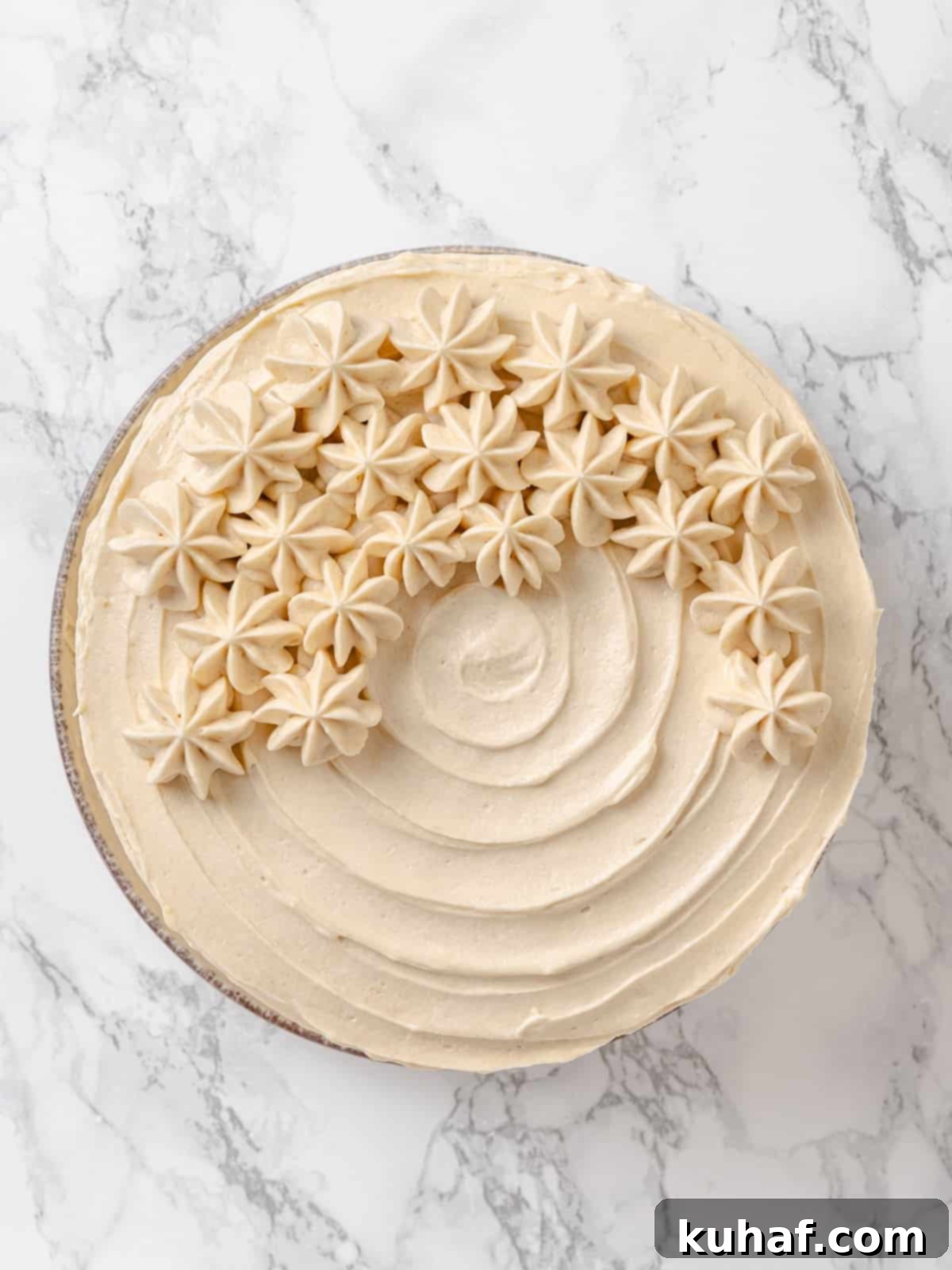
Recommended Fall Dessert Recipes
Looking for more delicious autumnal treats? Here are some fantastic recipes that pair beautifully with this maple frosting, or are simply perfect for the fall season:
Cupcake Recipes
Pumpkin Spice Cupcakes
Cake Recipes
Maple Pound Cake with Maple Glaze
Cake Recipes
Applesauce Cake
Fall Dessert Recipes
Pumpkin Pecan Pie Cupcakes
If you tried this recipe and absolutely loved it, please take a moment to leave a 🌟 star rating and share your experience in the comments below. I genuinely love hearing from you, and your feedback truly brightens my day!
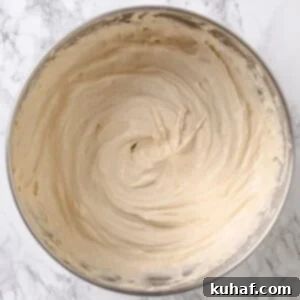
Maple Frosting
Pin Recipe
Comment
Print Recipe
Ingredients
- 10 tablespoons all-purpose flour
- 1 cup whole milk
- ¾ cup maple syrup grade A, dark amber
- ⅔ cup granulated sugar
- 2 teaspoons vanilla extract
- 1 teaspoon kosher salt
- 2 cups unsalted butter room temperature
Instructions
Make the flour base:
-
In a large saucepan, combine the flour, sugar, and salt. Stir to combine thoroughly.
-
Slowly whisk in the milk, adding just a little at a time, making sure it is completely incorporated before adding more to prevent lumps, similar to making homemade vanilla pudding. Whisk in the maple syrup.
-
Switch from the whisk to a silicone spatula and stir constantly over medium heat, scraping the bottom and sides of the pan to prevent burning.
-
Continue cooking until the flour mixture has thickened significantly and will drop off a spoon in distinct clumps rather than pour off in a stream. This typically takes about 20-25 minutes and is crucial for the frosting’s stability.
-
Remove from the heat and scrape the base into a large bowl with the spatula. Cover the top with plastic wrap pressed directly onto the surface, and allow to cool completely at room temperature until it is no longer warm to the touch. You can speed this up by cooling it in 20-minute intervals in the refrigerator, stirring and repeating until it reaches body temperature.
Make the frosting:
-
In the bowl of a stand mixer fitted with the whisk attachment, beat the cold but pliable butter on medium-high speed until it becomes fluffy and almost white in color, approximately 5-7 minutes.
-
With the mixer running on medium speed, gradually add the cooled maple mixture a spoonful at a time. Allow each addition to beat in fully before adding the next. Remember to scrape down the sides of the bowl as you go to ensure even mixing.
-
Stop the mixer to scrape in any remaining flour mixture from the spatula and thoroughly scrape down the sides and bottom of the bowl for a perfectly smooth consistency.
-
Add the vanilla extract and continue to whisk on high speed for another 3-5 minutes until the frosting is light, airy, and holds stiff peaks.
-
Transfer the finished maple frosting to a piping bag for decorating, or spread it generously on your favorite cakes and cupcakes.
Notes
Flavor Tips – If you desire a frosting with less sweetness, your best approach is to follow this recipe and reduce the granulated sugar as suggested. Alternatively, you could try my ermine frosting recipe and substitute some of the vanilla extract with a high-quality maple extract for a different intensity of maple flavor.
Technique Essentials – Always ensure your butter is cold but pliable, not melted or rock-hard. This is critical for achieving the correct emulsion and a stable, fluffy frosting. Also, thoroughly cook and completely cool the flour base; any warmth will cause the butter to melt.
Storage Guidance – Store any leftover maple frosting in an airtight container in the refrigerator for up to 2 weeks. For longer preservation, it can be frozen for up to 2 months. When ready to use from the fridge or freezer, allow it to come to room temperature, then re-whip it in a stand mixer until it regains its light consistency.
Nutrition
Before You Go
I sincerely hope you enjoyed creating and tasting this unique cooked flour maple frosting recipe. It’s a wonderful alternative to traditional buttercreams, offering a delightful blend of stability and authentic flavor. Don’t stop your frosting adventures here! Be sure to explore our other easy buttercream & frosting recipes, including a rich and decadent chocolate buttercream frosting recipe or my perfectly tangy cream cheese buttercream frosting. Happy baking!
